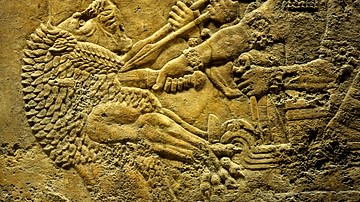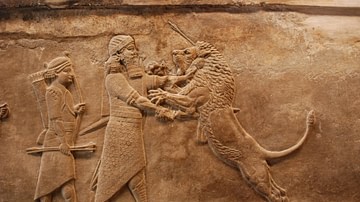Lexical lists are compilations of cuneiform signs and word readings written on clay tablets throughout Mesopotamia. From the late 4th millennium BCE up to the 1st century CE, scribal communities copied, modified, and passed on these cuneiform lexical lists and preserved them for as knowledge for a variety of purposes. Just as today people pass on and embrace the knowledge of scientific discoveries, lexical lists were the knowledge and intellectual material of the day when cuneiform writing emerged in the 4th millennium BCE. Including unpublished lexical lists, over 15,000 tablets exist. For the duration of the cuneiform lexical tradition, the meaning, purpose, and significance between world lists was in flux and development.

Description of Lexical Lists
In the simplest form, lexical lists may be divided into two categories: sign lists and word lists. The first primarily presents an inventory of signs along with their proper use. The second organizes cuneiform by semantics, which is the branch of linguistics and logic concerned with meaning, and is typically written in a thematic organization. Of course, some contain elements of both sign lists and word lists, indicative that we must permit a certain amount of fluidity when attempting to define lexical lists. Over time and with greater cultural interactions, they were further added upon with two columns, and sometimes three, in different languages in order to operate as transmitters of language for future generations. Although this description makes lexical lists seem mundane and pointless, they, in reality, can be used to understand historical developments and reconstruct the cultural landscape and ideas of the ancient Near East.
Brief History of Lexical Lists
In c. 3200 BCE, archaic writing of cuneiform was developed. During this period, the technology of writing was novel. Niek Veldhuis comments on the historical significance of archaic lexical lists: "The invention of a writing system is to be seen in the context of the development of standardized mass production and organized labor" (27). Consequently, a new class of society emerged, namely the scribal class, and lexical lists became a tool for constructing social identity within early scribal communities.
Moving into the 3rd millennium BCE, cuneiform lexical lists spread unevenly, which prevents strong conclusions from being made. Up to the Old Akkadian and Ur III periods (c. 2230 – 2004 BCE), lexical lists were primarily based in single locations, though not spread across Mesopotamia. In the Old Akkadian and Ur III periods, "the lexical material is reduced to a trickle" (Veldhuis, 142). Thus, for the duration of the 3rd millennium BCE, we only have evidence that lexical lists were primarily tools of authority, power, and leadership, not teaching within scribal communities. Importantly, in both the archaic lexical lists and those within the third millennium, there is great conservativeness, with many of the same texts being copied and written, with minor adjustments.
At the dawning of the second millennium, the Old Babylonian period (ca. 2000 – 1600 BCE), traditional texts from the archaic period and third millennium began to dwindle and new word lists and sign lists began to emerge. This period is extremely important in reconstructing the development of scribal practices and lexical lists because we see the establishment of an Old Babylonian scribal curriculum. Many of the texts from the archaic period became "teaching texts that introduced pupils to the invented tradition of a glorious Sumerian past" (Veldhuis, 218). Additionally, the new lexical lists, such as grammatical lists, found association with divinatory and mathematical literature rather than the scribal school. Third, we see the emergence of lexical lists oriented towards speculative philology, or the isolation of Sumerian symbols to translate them into Akkadian. This third category for usage of lexical lists is important because it marks the foundation of the social class of scholars. All in all, the developments during this period fit within the broader societal changes, namely the emergence of Babylonian elites.
Transitioning into the International period (c. 1600 – 1000 BCE), the late 2nd millennium, also known as the Late Bronze Age, Middle Babylonian, Kassite, Amarna, or Middle Assyrian periods, "saw an unprecedented spread of cuneiform writing and Babylonian written culture over the entire ancient Near East" (Veldhuis, 226). Reception of lexical lists during the period varied diversely because of different attitudes towards the cuneiform and the lexical tradition. During the International period, lexical lists began to splinter into various traditions, meaning that one could place two of the same lexical lists side by side and find variations. Most significant in terms of reception of lexical lists is Assyria's, who reacted with conservatism and embraced their Babylonian cultural heritage.
Overlapping with the International period, the early history of Assur, the heart of ancient Assyria, treated the Babylonian cultural heritage like holy writ, thereby redefining the character of scribal practice. With the acquisition and high value of this intellectual tradition, lexical lists became the literary technology in the Middle Assyrian period, which justified and cemented Assyria into a respected and ancient tradition. The fluidity of lexical lists during this period decreased and became objectified, frozen in time as a sort of canon. They were considered so because, to a certain extent, lexical lists symbolized primordial knowledge and "came to play a role in the management of power and legitimation of a world empire" (Veldhuis, 391).

Finally, in the Neo- and Late Babylonian period, scholarship, and thereby lexical lists, became the property and responsibility of temples and elite families in charge. Many of these late lexical lists include dedication prayers, indicative that writing and education were closely associated with temples and political leadership. Additionally, unlike the Old Babylonian period, lexical traditions ceased becoming the primary focus of scholarship; rather they became integral to further other areas of scholarship, such as celestial sciences and horoscopy.
Unfortunately, many lexical lists which possibly existed in the 1st century CE are now absent because the scribes chose to write with a different cultural medium brought by Hellenization, namely writing on parchment or other surfaces rather than clay tablets.
Final Remarks
From the archaic period up to the 1st century CE, roughly 3,300 years, the tradition of lexical lists developed into a source of knowledge and a political legitimation tool. Yet, during this long period of time, lexical lists maintained an important position within the cultural landscape because they represented the increasingly valuable technology of writing, a technology which eventually became associated with primordial knowledge. Through a lengthy reception history, many of the lexical lists from the archaic period were still utilized in the 1st century CE, a remarkable time for any literature to be remembered and well-received. In a world that takes writing and reading for granted, though, we would do well to remember that scribal practice, writing, and reading are all technologies and potential mediums for social, political, and religious change.







